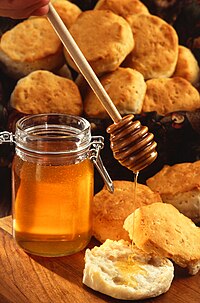
Photo from wikipedia
ABSTRACT Confections such as chocolate and biscuit fillings are composed of a continuous fat phase that contains dispersed nonfat ingredients such as sugar and cocoa powder. Research on fat crystallization… Click to show full abstract
ABSTRACT Confections such as chocolate and biscuit fillings are composed of a continuous fat phase that contains dispersed nonfat ingredients such as sugar and cocoa powder. Research on fat crystallization and rheology in confections often extrapolates crystallization and textural properties from bulk to mixed systems while overlooking the important role of composition or particle interactions. For example, in chocolate processing the fat phase aids dispersed phase lubrication and fluidity whereas the dispersed particles assist in fat crystallization by providing many nucleation sites. In confections with a high dispersed phase volume fraction, fat crystallization may be hindered due to reduced triacyglycerol mobility, confinement, and increased tortuosity. This is further complicated in systems with slow crystallizing fats such as palm oil whose crystallization is exceptionally sensitive to composition and processing. This review breaks down the physical chemistry of fat-based confections and discusses the impact of different nonfat ingredients towards fat crystallization and rheology. The behavior of palm oil is further highlighted as it is becoming increasingly popular as a confectionery ingredient. Lastly, ingredient-ingredient interactions and their role in fat crystallization are described along with force spectroscopy as a novel tool to characterize such phenomena. Force spectroscopy utilizes atomic force microscopy to measure intermolecular forces as a function of distance but remains largely unexplored in the area of food science.
Journal Title: Critical Reviews in Food Science and Nutrition
Year Published: 2018
Link to full text (if available)
Share on Social Media: Sign Up to like & get
recommendations!